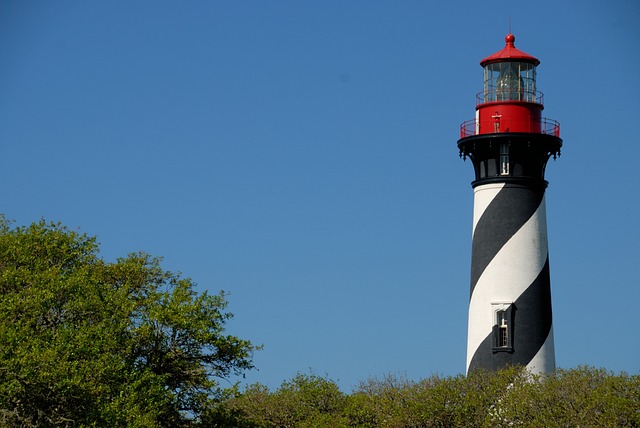Nestled on the northeastern coast of Florida, St. Augustine exudes an irresistible charm that resonates with its centuries-old history and coastal allure. As the oldest European-established city in the United States, St. Augustine carries a weighty sense of heritage, seamlessly blending the old and the new to create a captivating destination.
Walking through the streets of St. Augustine feels like stepping into a living history book. The city’s architecture whispers stories of its Spanish colonial past, with narrow cobblestone streets winding past well-preserved structures adorned with ornate balconies and red-tiled roofs. The impressive Castillo de San Marcos, an imposing fortress made of coquina stone, stands as a sentinel, bearing witness to the struggles and triumphs of bygone eras.
The heart of St. Augustine lies within its historic district, a vibrant tapestry of shops, restaurants, and museums. St. George Street, a bustling pedestrian thoroughfare, invites exploration with its array of quaint boutiques, art galleries, and souvenir shops. The aromas of freshly brewed coffee and delectable cuisine waft through the air, enticing visitors to sample the flavors of the city’s diverse culinary scene.
A visit to St. Augustine wouldn’t be complete without immersing oneself in the wealth of historical sites and cultural landmarks. The Flagler College campus, housed within the opulent former Hotel Ponce de Leon, showcases breathtaking Spanish Renaissance architecture and houses an impressive collection of Tiffany stained glass windows. Nearby, the Lightner Museum displays a treasure trove of eclectic exhibits, ranging from Victorian artifacts to a mesmerizing collection of fine art.
Beyond the city’s historical tapestry, St. Augustine offers a tranquil escape to its sun-kissed shores. St. Augustine Beach beckons with its expansive stretches of sandy coastline, where visitors can bask in the warm Florida sunshine, indulge in water sports, or simply relish the rhythmic symphony of crashing waves.
Throughout the year, St. Augustine comes alive with a vibrant calendar of events and festivals that celebrate its heritage and culture. From colorful parades and lively music festivals to the enchanting Nights of Lights when the city is draped in millions of sparkling bulbs, there is always something to enthrall and entertain.
St. Augustine’s allure lies in its ability to transport visitors through time, inviting them to connect with the past while reveling in the delights of the present. With its historical significance, architectural beauty, coastal splendor, and an unmistakable sense of place, St. Augustine offers an unforgettable experience that lingers long after the journey ends.
St. Augustine, Florida is known for several notable features and historical significance. Here are some key points about what St. Augustine is known for:
1. Oldest European-Settled City: St. Augustine is recognized as the oldest continuously occupied European-established settlement in the United States. It was founded by Spanish admiral Pedro Menéndez de Avilés on September 8, 1565, making it over 450 years old.
2. Spanish Colonial Architecture: The city boasts a rich architectural heritage, characterized by Spanish colonial-style buildings. Historic structures like the Castillo de San Marcos, a 17th-century fortress made of coquina stone, and the St. Augustine Light, an active lighthouse, are prime examples of the city’s architectural charm.
3. St. Augustine Historic District: The St. Augustine Historic District is a prominent attraction, encompassing a large area of the city’s downtown. It is home to numerous historic sites, including the Spanish Quarter, St. George Street (a pedestrian-only street lined with shops, restaurants, and historic buildings), and the Flagler College campus, housed in the former Hotel Ponce de Leon.
4. Fountain of Youth Archaeological Park: St. Augustine is famous for the Fountain of Youth Archaeological Park, which is believed to be the site where Spanish explorer Juan Ponce de León landed in his quest for the legendary Fountain of Youth. Visitors can explore the park, drink from the “fountain,” and learn about the area’s history through exhibits and demonstrations.
5. St. Augustine Beach: The city’s proximity to the Atlantic Ocean gives rise to St. Augustine Beach, a popular destination for locals and tourists alike. Visitors can enjoy the sandy beaches, engage in water activities, and soak up the sun.
6. Events and Festivals: St. Augustine hosts various events and festivals throughout the year. Notable celebrations include the St. Augustine Easter Parade, St. Augustine Seafood Festival, St. Augustine Celtic Music & Heritage Festival, Nights of Lights (an annual holiday lighting event), and many others.
7. Historical Significance: St. Augustine played a significant role in the early exploration and colonization of the Americas. It was a vital Spanish outpost, served as the capital of Spanish Florida, and witnessed conflicts between European powers seeking control of the region. The city’s historical significance is preserved and celebrated through its numerous museums, historical sites, and reenactments.
These are just a few highlights of what St. Augustine, Florida is known for. The city’s rich history, architectural beauty, and coastal charm make it a popular tourist destination that attracts visitors from around the world.




